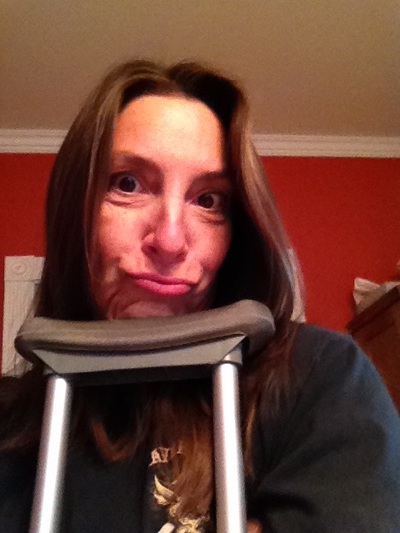|
Approximately two years ago, I injured my knee doing something I love — powerlifting. Not realizing the extent of my injury, I kept working out after it appeared better, succumbing to the desire to finish a fitness-related competition I’d already begun. We can just call that pigheadedness or blind hope.
The result was grisly, because as I performed the last repetition of the final exercise, I dropped to the floor, screaming in anguish from the pain of fully severing my anterior cruciate ligament (ACL). I can still hear my scream, embedded in the recesses of my memory. I’ll bet the few folks who were there with me that day can, too. I’d never been injured, really, before that day. I’d broken a couple of baby toes, had a handful of stitches and some nagging irritations such as tendonitis. But I knew, without a shadow of a doubt, that something major had occurred in that moment. As things unfolded, I learned what was to come: surgery, reconstruction of my apparatus using a cadaver tendon, lots of physical therapy and possibly eliminating certain exercise movements forever. What came next was a near-suffocating wave of grief lasting weeks. I felt helpless and uncertain. Would I recover? How long would it take? And were my powerlifting days over? There was simply no way to know what lay ahead. The ACL tear is common, especially for athletes, but the average person can do it attending to the most mundane of tasks, such as laundry. Some athletes who tear their ACLs have surgery and return to their sport reportedly like new. Others admitted theirs have never been the same. Young athletes have a good shot at full recovery. For folks like me, who have passed the 50-year-old mile marker, the results weren’t so clear. My husband, who has never torn his ACL but racked up a number of knee surgeries and sustained several other significant injuries throughout his lifetime, warned me my knee would never been the same. I remained optimistic anyway. I had the surgery, was an invalid for a while, then got back on my horse and started rehabbing. To say the process has been slow is an understatement. Not having any benchmark for expectations, I plodded along trying to stay positive and not feel discouraged. Not all of my muscles want to fire like they should or used to, and sometimes I have to urge them along. My brain tries to compensate for my knee by doing all of the wrong things. It requires constant supervision, like a toddler. Take last week, when I was in our nation’s capital visiting my in-laws. We went to two crowded venues, including a Nats game. When I am faced with a sea of people, it’s almost like being in a video game, where I have to make it out alive. It requires extra vigilance to dodge people — many who are situationally unaware — and avoid potential mishaps. Also, the mere idea of some activities, like skiing or a friendly game of flag football, makes me visibly wince. And even after close to two years of recovery, there are days it still feels like a small alien is living in my knee. As you can imagine, powerlifting has been off the table. Rehab meant lifting no weight and gradually adding it in. Sometimes it’s been two steps forward and three back. My knee doth protest. It also made doing my favorite form of exercise — CrossFit — a challenge. I tried at various times to make it work, scaling however necessary and focusing on what I could do instead of what I couldn’t. But by and large, I found it easier and better for my rehab to take walks, focus on getting my form back and limit the weightlifting. Through the process, my outlook and goals about fitness have changed. You better learn from the hard knocks or else it’s for nothing. So today, I have some new mantras. Form first — concentrate. Be conservative — but still intrepid. Use your brain — and go the distance. August 1, I returned to CrossFit. My heart sang after the first workout because to me, it feels like a second home. I actually thought: All is right in the world. Before the injury, my powerlifting was pretty impressive. And in the last two weeks, I see how far I’ve come and it gives me hope. I tied my former personal best bench-press at 115 pounds and I deadlifted just over 200 pounds, making real progress towards my old record of 265. Maybe it’s the feel-good Olympics or my hormonally charged menopause, but tears of joy and relief are prevalent with these little mile markers. I am seeing that hard work pays off and feeling inspired by my own self. This column aired in The Journal on Sunday, August 14, 2016.
4 Comments
Jami Hadden
8/14/2016 09:41:49 pm
This was so timely for me to read! I'm at the one-year mark for a back injury, and while not as debilitating for me as your progress from knee aurgery, I relate so much to the form focus. I haven't done a deadlift yet over 115lbs, and wit any weight movement, it's light, with the inner mantra of form. And stopping, and re-focusing as needed. You and others give me inspiration to keep moving forward. Thank you!!!
Reply
Katherine
8/15/2016 08:06:42 am
Thank you. We're all in this together, Jami! Keep moving forward. You've got this.
Reply
jean
8/15/2016 01:41:06 pm
your amazing cousin i love ya
Reply
Ursula
8/16/2016 08:20:15 pm
Your awesome!! :) xoxo
Reply
Leave a Reply. |
Summary
A collection of columns, articles and general a-musings. Archives
July 2024
|
Katherine Cobb







